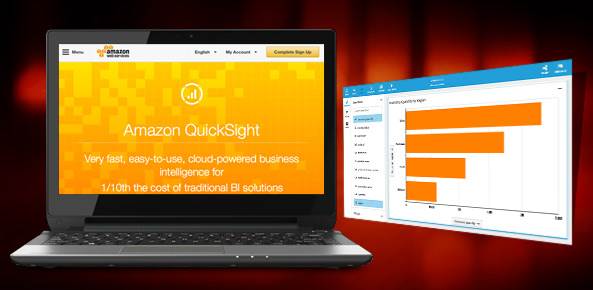QuickSight from Amazon is giving business intelligence (BI) a cloud twist. Announced today at its re:Invent 2015 conference in Las Vegas, Amazon Web Services (AWS) is positioning the new tool as a way to make it easy for just about anybody to build visualizations, perform ad-hoc analysis and tap into business insights from data on hand.
Amazon QuickSight uses what the company called a “super-fast, parallel, in-memory calculation engine,” or SPICE for short, to roll out calculations and visualizations. The technology automatically integrates with AWS data services and makes it possible for organizations to scale to hundreds of thousands of users.
Amazon says SPICE works using a combination of columnar storage, in-memory technologies made possible by hardware innovations, machine code generation, and data compression to allow users to run interactive queries on large datasets and get rapid responses.
“In a world increasingly dominated by connected devices and mobile users and where corporate data is moving to the cloud, our customers continue to collect and store massive amounts of their data across a wide range of AWS’ data services,” said Raju Gulabani, vice president of database services at Amazon Web Services, in a statement. “These customers have been asking AWS for an analytics solution that can enable every one of their users to gain insights and make rapid decisions using this data.”
Where’s the Beef?
Here’s Amazon’s pitch: Many BI solutions demand that data engineering teams spend weeks or months building complex data models before an end user can generate even a single report. That’s a common complaint — and it’s not new.
Amazon said the feedback from its customers suggests that many BI solutions lack interactive data exploration and visualization, which limits users to canned reports and pre-selected queries. And that’s not the only complaint with the status quo of the BI market.
The company also pointed to on-premises BI tools from other vendors that require companies to invest in complex and costly hardware and software — then on top of that to invest in even more infrastructure to maintain fast query performance as the size of their databases grow. The bottom line: The cost and complexity makes it difficult for companies to make BI ubiquitous across their organizations.
Amazon QuickSight aims to answer those objections and so far it seems to be getting a warm reception. In its announcement, Amazon included endorsements from Nasdaq, Intuit and AdRoll (a retargeting platform) and RetailMeNot (a marketplace platform for digital offers). Amazon has also inked partnerships with the likes of Domo, Qlik, Tableau, and Tibco.
The X Factors
We asked Charles King, principal analyst at Pund-IT, for his thoughts on the new product. He told us that from the looks of it, QuickSight is an interesting service that Amazon believes will disrupt traditional BI solutions and vendors.
“On the surface, that seems to be the case, especially given Amazon’s aggressive pricing — $ 9 per user per month, which it claims is one-tenth the cost of other tools,” King said. He noted that makes sense except for two issues.
The first question is how well Amazon’s new tools and services actually work, he said. Amazon Web Services has a “pretty good” track record in this respect so it should work out for the company over time. On the other hand, it also means that it will take customers months to test and validate QuickSight before they begin using it regularly, let alone replacing their existing BI deployments and solutions, he said.
“Second, and more importantly, QuickSight only works for data residing in AWS repositories. For the many enterprises that keep sensitive, contemporaneous data out of public cloud environments, QuickSight will likely be a non-entity or of passing interest,” King said. “Overall, QuickSight is an interesting new solution, particularly for existing AWS customers looking for ways to trim BI usage costs. But it’s unlikely to be as immediately disruptive or successful as Amazon hopes.”







